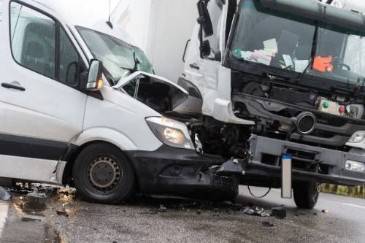When you are merging or making a turn, you most likely glance over your shoulder to check your blind spot. A blind spot is the area near the back corner of a car that neither the side nor the rearview mirror can see. This area should always be checked when a driver is changing lanes, otherwise he or she could slam into another car.
 What many drivers may not realize, however, is that the blind spots on a commercial truck are much larger — and far easier to get stuck in than your standard passenger vehicle. Anyone who gets behind a wheel should keep the blind spots of big rigs in mind. Otherwise, they may find themselves in a serious accident.
What many drivers may not realize, however, is that the blind spots on a commercial truck are much larger — and far easier to get stuck in than your standard passenger vehicle. Anyone who gets behind a wheel should keep the blind spots of big rigs in mind. Otherwise, they may find themselves in a serious accident.
Why Trucks Have Bigger Blind Spots
Trucks are much larger than the average four-door sedan. A standard semi-truck spans about 70 feet and can take up almost an entire lane in width. Trucks also sit much higher up than cars, causing further obstructions to their driver’s view. This means that a truck’s blind spots, also known as “no-zones” are much larger than those on a car. While the designers of semi-trucks try to compensate for this by using larger mirrors, the mirrors not nearly large enough to eliminate blind spots altogether. As a result, there are areas around the truck that the driver simply cannot see.
While avoiding these “no-zones” completely is impossible, staying in them for longer than a few seconds is incredibly dangerous. A truck driver must always check the blind spots before changing lanes, but not all drivers take this responsibility seriously. If a truck driver begins to merge when you are in a blind spot, you could be caught in an underride accident with severe injuries. Many who experience these collisions even lose their lives. Knowing where a truck’s blind spots are and avoiding them at all costs is an important step in ensuring your own safety.
Avoiding a Truck’s Blind Spots
A truck has four no-zones; the four areas you should always try to avoid when driving nearby. They are:
- Up to twenty feet in front of the truck
- Up to thirty feet behind the truck
- From the cab mirror on the left side out across one lane
- From the cab mirror on the right side out across two lanes
Your best bet is to drive one or two lanes to the side of the truck and remain a substantial distance ahead of or behind it. If you must be directly in front of or behind a truck, keep at least thirty feet between you at street speeds. On a highway, you should allow for more. Trucks take a long time to slow down, and if you are directly in front of the truck and hit your brakes, the driver will not be able to see you to react in time.
If you are directly to the side of the truck, try to remain closer to the trailer than the cab. The most dangerous place to be is right next to the cab, behind the side mirror. The trucker will not be able to see you there, and if he begins to merge, he could collide with you. It is best if you can either speed ahead of the truck or slow down enough to be slightly behind it. That way, you are avoiding its blind spots.
As technology improves, there may come a day where trucks do not have blind spots anymore. However, that day is yet to come. Currently, trucks and their no-zones are incredibly dangerous. If you have been involved in a truck accident because the driver neglected to check their blind posts, then you are in need of an excellent Colorado Springs truck accident attorney. Call our firm, The Bussey Law Firm, P.C., at (719) 475-2555 to speak with a member of our incredible legal team. We are ready to help you.
